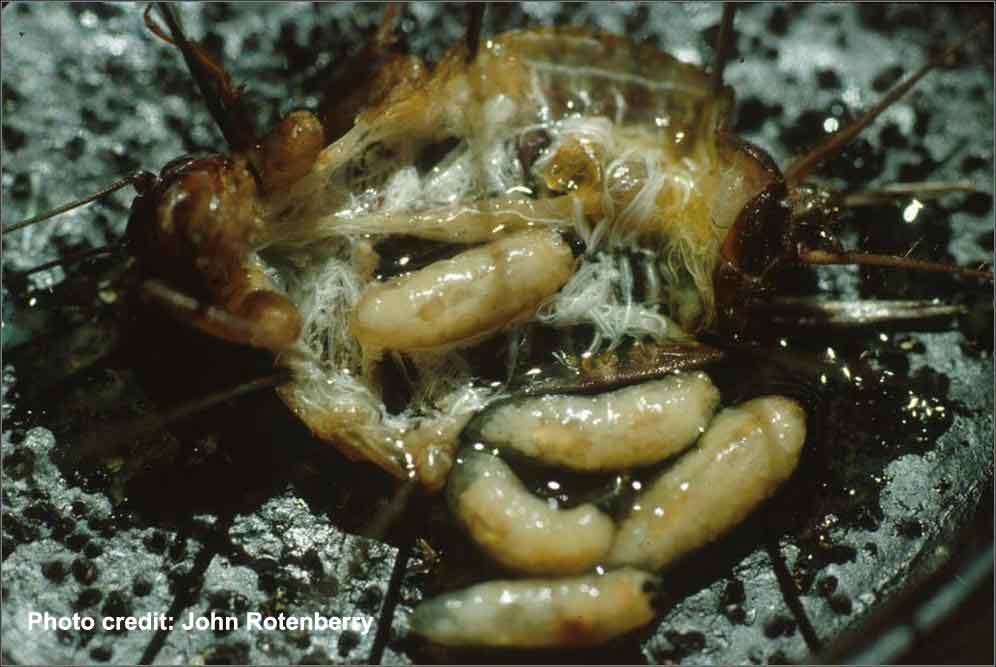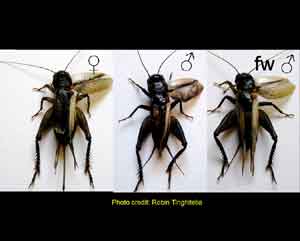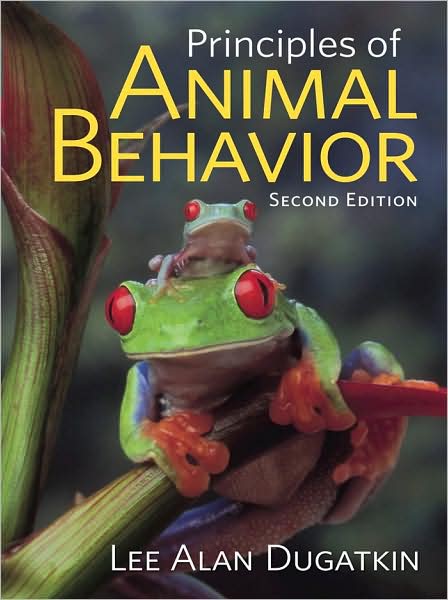 |
Research in the Zuk lab
 |
Rapid evolution of a sexual signal in the field cricket, Teleogryllus
oceanicus |
 The dulcet tones of
cricket song that we find so relaxing on warm evenings are
actually the advertisement calls of sexually
receptive males. A nasty threat looms
over Teleogryllus oceanicus populations
in Hawaii, however. A villain of the blackest dye, the parasitoid
fly Ormia ochracea, emerges at night to prey on hapless male
crickets. Female flies home in on male cricket song, and squirt
live larvae onto their hosts. Larvae then burrow through the
cuticle and feast on various internal cricket structures. After a
week or so, the engorged, pulsing maggots burst out of their host, leaving a hollow cricket husk behind. Clearly, this is not
a desirable situation to be in if you are a male cricket. Our
research team has recently made an astonishing discovery
on the Hawaiian island of Kauai. In 2003, an
e The dulcet tones of
cricket song that we find so relaxing on warm evenings are
actually the advertisement calls of sexually
receptive males. A nasty threat looms
over Teleogryllus oceanicus populations
in Hawaii, however. A villain of the blackest dye, the parasitoid
fly Ormia ochracea, emerges at night to prey on hapless male
crickets. Female flies home in on male cricket song, and squirt
live larvae onto their hosts. Larvae then burrow through the
cuticle and feast on various internal cricket structures. After a
week or so, the engorged, pulsing maggots burst out of their host, leaving a hollow cricket husk behind. Clearly, this is not
a desirable situation to be in if you are a male cricket. Our
research team has recently made an astonishing discovery
on the Hawaiian island of Kauai. In 2003, an
e erie
silence had descended on the population. Had
all the males
ceased calling? Had the population gone extinct? After some
investigation, we discovered that a dramatic morphological mutation had
arisen in some males, causing the loss of sound-producing structures on their wings (larger image). These flatwing males are protected from
predation by acoustically orienting parasitoids. The proportion of flatwing males on Kauai has
increased from zero to nearly 90 percent in fewer than 30 generations,
representing one of the fastest evolutionary shifts documented in a
wild population. We are currently investigating the extent to
which pre-existing behaviors facilitated the emergence and spread of
this mutation, providing new and exciting insights into the
interactions between behavior
and evolutionary change. erie
silence had descended on the population. Had
all the males
ceased calling? Had the population gone extinct? After some
investigation, we discovered that a dramatic morphological mutation had
arisen in some males, causing the loss of sound-producing structures on their wings (larger image). These flatwing males are protected from
predation by acoustically orienting parasitoids. The proportion of flatwing males on Kauai has
increased from zero to nearly 90 percent in fewer than 30 generations,
representing one of the fastest evolutionary shifts documented in a
wild population. We are currently investigating the extent to
which pre-existing behaviors facilitated the emergence and spread of
this mutation, providing new and exciting insights into the
interactions between behavior
and evolutionary change.  Our work on this system now features in the most recent edition of "Principles of Animal Behavior" by LA Dugatkin. For further reading, check out:
|
Evolution
of Sex Differences in Disease Susceptibility |
In many animal species, females have more
robust immunity and are less likely to harbor parasites than males.
Why is that? Comparative and theoretical work from current and
former lab members has examined the evolutionary causes of sex-biased
parasitism and immune responses, placing these traits in the context of
sexual selection. Check out:
|
Sex and Gender in Humans and
Animals |
 Those of
us who study sexual behavior in animals have noticed that people like
to apply what we learn to their own behavior. We often get people
asking questions like, "Is monogamy natural?" or "Does homosexuality
exist in non-humans?" Marlene Zuk and others in the lab enjoy
interacting with other scientists as well as the general public in
discussions of these and related issues, and if you are interested, you can check out some of the following: Those of
us who study sexual behavior in animals have noticed that people like
to apply what we learn to their own behavior. We often get people
asking questions like, "Is monogamy natural?" or "Does homosexuality
exist in non-humans?" Marlene Zuk and others in the lab enjoy
interacting with other scientists as well as the general public in
discussions of these and related issues, and if you are interested, you can check out some of the following:
|